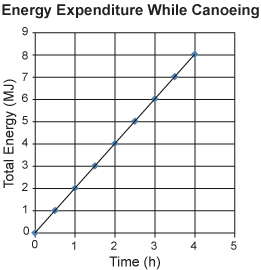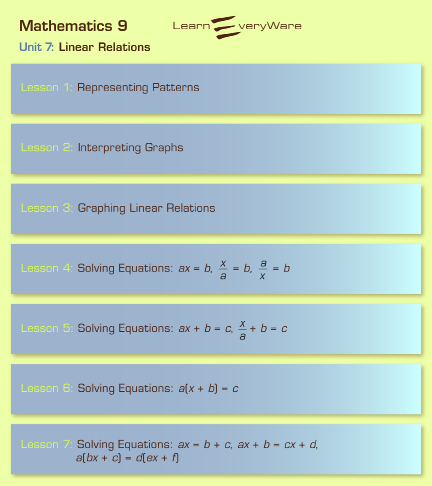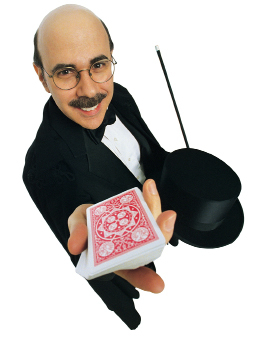Unit 7
Unit 7
Unit 7 Introduction

Travel Alberta
Outdoor adventurists can spend days or weeks exploring. Sometimes, these outdoor areas are very remote and far away from any modern-day conveniences, such as grocery stores. When exploring, adventurists have to bring in their own supplies, including food and water. There needs to be enough supplies to last the length of the trip, plus some extra in case of an emergency.
The amount of food and water required depends on the energy requirements of the individual or group. The amount of energy will vary depending on the type of activity. For instance, the energy used to row a canoe or to kayak will be different than the energy used to hike up a mountain. The energy expenditure will also vary depending on the level of fitness and mass of an adventurist. The nutritional content of the food the adventurist will be consuming also needs to be determined. Some foods are more energy rich or energy dense than others.
The relationship between all of these factors must be taken into consideration when planning trips. For some, the relationship can be represented by a linear relation. In a linear relation, the relationship between the variables changes at a constant rate.
linear relation: a pattern made by a set of points on a graph that lie in a straight line
linear equation: an equation, the graph of which has points that lie in a straight line
For instance, the amount of energy burned by a 70-kg adventurist while canoeing can be represented by the following linear equation, where y represents the total energy measured (in megajoules) and x represents the number of hours canoeing at a moderate pace. The numerical coefficient 2 represents the amount of energy burned per hour of canoeing.

Recall that when a linear equation is graphed, its points lie in a straight line.

You have investigated linear relations in previous mathematics courses. You will continue to explore linear relations and their graphs and use linear equations to model and solve various problems throughout Unit 7.
In this unit you will investigate the following critical questions:
- How can values between and beyond known values of a linear relation be determined?
- How can linear equations be used to solve problems?
The concepts and skills associated with linear relations will be presented in seven lessons.

Keep up to your assignments as you go through this unit. Keep your work organized, either electronically or in a paper version. This will help you to review and reference the lessons you have learned. Reviewing may help you on tests or while you are working on the unit project. Be sure to talk to your teacher about when and how to submit your assignments.
In this unit there are a variety of assignments you will be asked to complete. Some of these include the following:
- posting to the discussion board
- adding samples of your work to your Math 9 course folder
- developing a formula sheet
- completing sets of questions for each lesson
- completing a unit project
- completing evaluation pieces assigned by your teacher
Strategies for Success
In order to support your success in this unit, follow these strategies.
Strategy 1

Throughout this course, you will build a formula sheet using a spreadsheet program. The purpose of this project is to produce a formula sheet that you can use to quickly identify specific formulas and their uses. It will also provide a way for discussion, analysis, and review of these formulas with your peers.
- The specific instructions and requirements for the formula sheet are provided to you in the Course Introduction.
- Keep a look out for the formula sheet icon. This is an indication that you can add that formula in your spreadsheet.
Strategy 2
In this unit you will be working with two different chapters in the MathLinks 9 textbook: Chapter 6 and Chapter 8. You can make two separate foldables for this unit—one for Chapter 6 and one for Chapter 8. Refer to page 208 in the textbook for detailed instructions on creating your foldable for Chapter 6. The instructions for the foldable for
Chapter 8 can be found on page 290 of your textbook.
Although the foldables may not be graded for marks, you will benefit from this tool. Keep these points in mind as you develop and use this study tool.
- Add formulas, diagrams, examples, key ideas, and glossary words as you work through the lessons.
- Each foldable can serve as a quick reference guide and will help you save time when you are ready to study for your unit test.
Strategy 3
As noted, you will be referring to Chapter 6 and Chapter 8 of your textbook in this unit. The pages you will be looking at for Chapter 6 are pages 206 to 249. Chapter 8 is on pages 288 to 335.
- Take time to flip through these textbook pages.
- Look at illustrations, margin features, and main titles to get a sense of where you will be going.
Strategy 4
Read your lessons and textbook materials carefully.
- Pay special attention to tables and diagrams. They have information that will help you understand what you are reading.
- Read and reread material. Take time to ensure you understand it.
- Ask yourself: What is new material to me? What do I already know?
- Move ahead with confidence.
Unit 7 Project

Comstock/Thinkstock
For the Unit 7 Project, you will plan a canoe trip. As part of your planning, you will be responsible for determining the amount of food supplies needed to meet the energy requirements of your group. To help you complete the first part of the project, you will work through the “Math Link” activities in Chapter 6 on pages 209, 219, 230, 243, and 247.
In the second part of your project, you will investigate the relationship between nutritional content and the serving size or mass of different foods. The “Math Link” activities in Chapter 8 on pages 291, 303, 313, 321, 329, and 333 will be used to help you use nutritional data to write and solve word problems that can be represented by linear equations.

It is important that you keep your work organized in your portfolio as you progress through each lesson.
As you complete the Unit 7 Project, you may want to refer to the Unit 7 Project Self-Assessment Rubric.
You can use this rubric to help you understand how the project will be assessed. The better you understand what the characteristics of quality work are for the project, the easier it will be for you to create high quality work. Remember that you can always discuss your project with your teacher if you have questions or are unclear about a requirement of any of the project components.
Are you ready for the adventure of linear relations to begin? It all starts in Lesson 1 with an exploration of patterns.